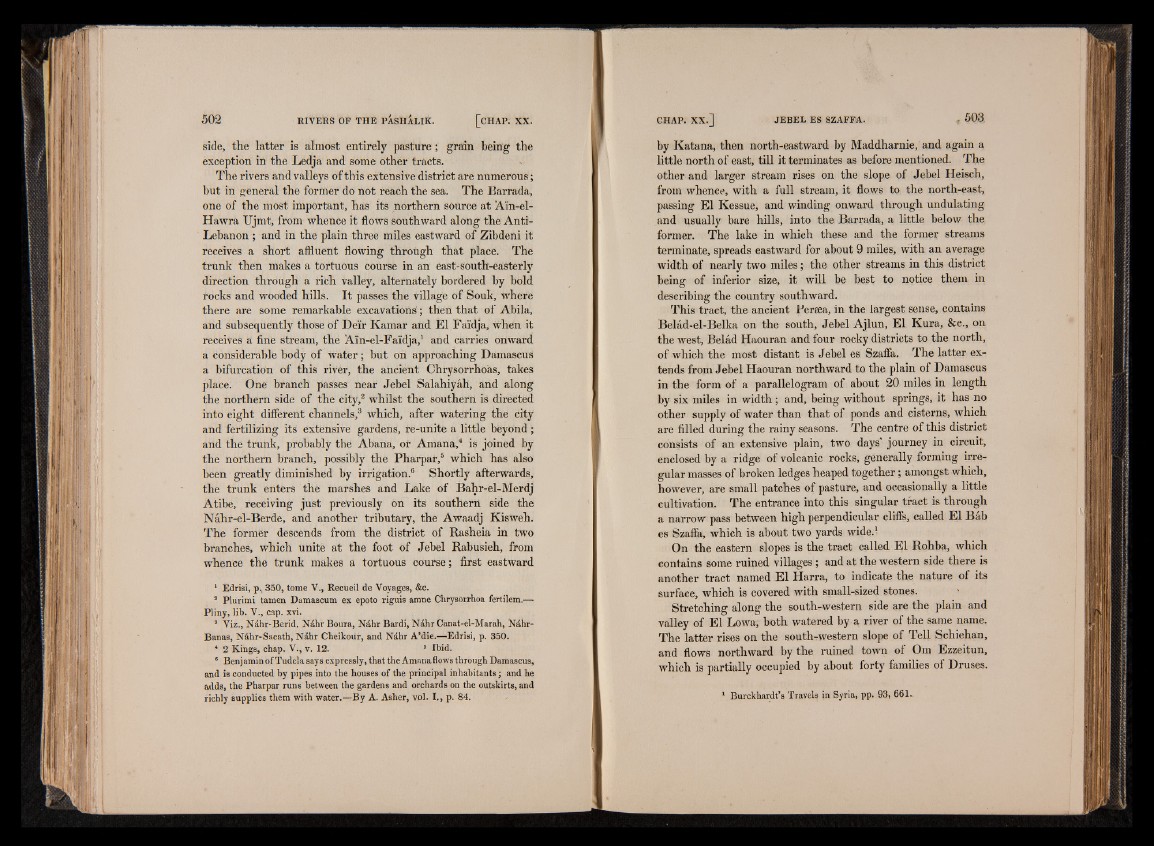
side, the latter is almost entirely pasture ; grain being the
exception in the Ledja and some other tracts.
The rivers and valleys of this extensive district are numerous;
but in general the former do not reach the sea. The Barrada,
one of the most important, has its northern source at Ain-el-
Hawra Ujmt, from whence it flows southward along the Anti-
Lehanon ; and in the plain three miles eastward of Zibdeni it
receives a short affluent flowing through that place. The
trunk then makes a tortuous course in an east-south-easterly
direction through a rich valley, alternately bordered by bold
rocks and wooded hills. It passes the village of Souk, where
there are some remarkable excavations'; then that of Abila,
and subsequently those of Deir Kamar and El Faidja, when it
receives a fine stream, the Ai'n-el-Faidja,1 and carries onward
a considerable body of water; but on approaching Damascus
a bifurcation of this river, the ancient Chrysorrhoas, takes
place. One branch passes near Jebel Salahiyah, and along
the northern side of the city,2 whilst the southern is directed
into eight different channels,3 which, after watering the city
and fertilizing its extensive gardens, re-unite a little beyond ;
and the trunk, probably the Abana, or Amana,4 is joined by
the northern branch, possibly the Pharpar,6 which has also
been greatly diminished by irrigation.6 Shortly afterwards,
the trunk enters the marshes and Lake of Bahr-el-Merdj
Atibe, receiving just previously on its southerii side the
Nahr-el-Berde, and another tributary, the Awaadj Kisweh.
The former descends from the district of Rasheia in two
branches, which unite at the foot of Jebel Rabusieh, from
whence the trunk makes a tortuous course; first eastward
1 Edrisi, p., 350, tome V., Recueil de Voyages, &c.
3 Plurimi tamen Damascum ex epoto riguis amne Chrysorrhoa fertilem.—
Pliny, lib. V., cap. xvi.
3 Viz., Nahr-Berid, Ndhr Boura, Ndhr Bardi, Ndhr Canat-el-Marah, Ndhr-
Banas, Ndhr-Sacath, Ndhr Cheikour, and Ndhr A’die.—Edrisi, p. 350.
4 2 Kings, chap. V., y. 12. 5 Ibid.
8 Benjamin of Tudela says expressly, that the Amana flows through Damascus,
and is conducted by pipes into the houses of the principal inhabitants; and he
adds, the Pharpar runs between the gardens and orchards on the outskirts, and
richly supplies them with water.—By A. Asher, vol. I., p. 84.
by Katana, then north-eastward by Maddharnie, and again a
little north of east, till it terminates as before mentioned. The
other and larger stream rises on the slope of Jebel Heisch,
from whence, with a full stream, it flows to the north-east,
passing El Kessue, and winding onward through undulating
and usually bare hills, into the Barrada, a little below the
former. The lake in which these and the former streams
terminate, spreads eastward for about 9 miles, with an average
width of nearly two miles; the other streams in this district
being of inferior size, it will be best to notice them in
describing the country southward.
This tract, the ancient Pereea, in the largest sense, contains
Belad-el-Belka on the south, Jebel Ajlun, El Kura, &e., on
the west, Belad Haouran and four rocky districts to the north,
of which the most distant is Jebel es Szaffa. The latter extends
from Jebel Haouran northward to the plain of Damascus
in the form of a parallelogram of about 20 miles in length
by six miles in width; and, being without springs, it has no
other supply of water than that of ponds and cisterns, which
are filled during the rainy seasons. The centre of this district
consists of an extensive plain, two days journey in circuit,
enclosed by a ridge of volcanic rocks, generally forming irregular
masses of broken ledges heaped together; amongst which,
however, are small patches of pasture, and occasionally a little
cultivation. The entrance into this singular tract is through
a narrow pass between high perpendicular cliffs, called El Bab
es Szaffa, which is about two yards wide.1
On the eastern slopes is the tract called El Rohba, which
contains some ruined villages; and at the western side there is
another tract named El Harra, to indicate the nature of its
surface, which is covered with small-sized stones.
Stretching along the south-western side are the plain and
valley of El Lowa, both watered by a river of the same name.
The latter rises on the south-western slope of Tell Schiehan,
and flows northward by the ruined town of Om Ezzeitun,
which is partially occupied by about forty families of Druses.